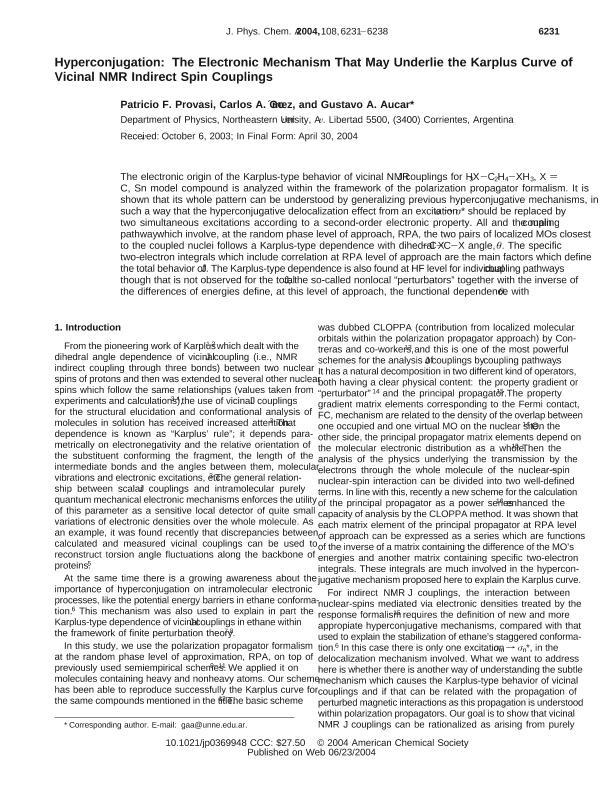Mostrar el registro sencillo del ítem
dc.contributor.author
Provasi, Patricio Federico

dc.contributor.author
Gómez, Carlos Anselmo

dc.contributor.author
Aucar, Gustavo Adolfo

dc.date.available
2017-08-08T18:05:20Z
dc.date.issued
2004-06
dc.identifier.citation
Provasi, Patricio Federico; Gómez, Carlos Anselmo; Aucar, Gustavo Adolfo; Hyperconjugation: the electronic mechanism that may underlie the Karplus curve of vicinal NMR indirect spin couplings; American Chemical Society; Journal of Physical Chemistry A; 108; 29; 6-2004; 6231-6238
dc.identifier.issn
1089-5639
dc.identifier.uri
http://hdl.handle.net/11336/22023
dc.description.abstract
The electronic origin of the Karplus-type behavior of vicinal NMR J couplings for H3X−C2H4−XH3, X = C, Sn model compound is analyzed within the framework of the polarization propagator formalism. It is shown that its whole pattern can be understood by generalizing previous hyperconjugative mechanisms, in such a way that the hyperconjugative delocalization effect from an excitation σ → σ* should be replaced by two simultaneous excitations according to a second-order electronic property. All and the main coupling pathway which involve, at the random phase level of approach, RPA, the two pairs of localized MOs closest to the coupled nuclei follows a Karplus-type dependence with dihedral X−C−C−X angle, θ. The specific two-electron integrals which include correlation at RPA level of approach are the main factors which define the total behavior of J. The Karplus-type dependence is also found at HF level for individual coupling pathways though that is not observed for the total J; the so-called nonlocal “perturbators” together with the inverse of the differences of energies define, at this level of approach, the functional dependence with θ.
dc.format
application/pdf
dc.language.iso
eng
dc.publisher
American Chemical Society

dc.rights
info:eu-repo/semantics/openAccess
dc.rights.uri
https://creativecommons.org/licenses/by-nc-sa/2.5/ar/
dc.subject
Nmr
dc.subject
Spin-Spin Coupling Constant
dc.subject
Karplus Curve
dc.subject
Hyperconjugation
dc.subject.classification
Otras Ciencias Físicas

dc.subject.classification
Ciencias Físicas

dc.subject.classification
CIENCIAS NATURALES Y EXACTAS

dc.title
Hyperconjugation: the electronic mechanism that may underlie the Karplus curve of vicinal NMR indirect spin couplings
dc.type
info:eu-repo/semantics/article
dc.type
info:ar-repo/semantics/artículo
dc.type
info:eu-repo/semantics/publishedVersion
dc.date.updated
2017-08-04T15:40:52Z
dc.journal.volume
108
dc.journal.number
29
dc.journal.pagination
6231-6238
dc.journal.pais
Estados Unidos

dc.journal.ciudad
Washington D. C.
dc.description.fil
Fil: Provasi, Patricio Federico. Consejo Nacional de Investigaciones Científicas y Técnicas; Argentina. Universidad Nacional del Nordeste. Facultad de Ciencias Exactas y Naturales y Agrimensura. Departamento de Física; Argentina
dc.description.fil
Fil: Gómez, Carlos Anselmo. Consejo Nacional de Investigaciones Científicas y Técnicas; Argentina. Universidad Nacional del Nordeste. Facultad de Ciencias Exactas y Naturales y Agrimensura. Departamento de Física; Argentina
dc.description.fil
Fil: Aucar, Gustavo Adolfo. Consejo Nacional de Investigaciones Científicas y Técnicas; Argentina. Universidad Nacional del Nordeste. Facultad de Ciencias Exactas y Naturales y Agrimensura. Departamento de Física; Argentina
dc.journal.title
Journal of Physical Chemistry A

dc.relation.alternativeid
info:eu-repo/semantics/altIdentifier/doi/http://dx.doi.org/10.1021/jp0369948
dc.relation.alternativeid
info:eu-repo/semantics/altIdentifier/url/http://pubs.acs.org/doi/10.1021/jp0369948
Archivos asociados
